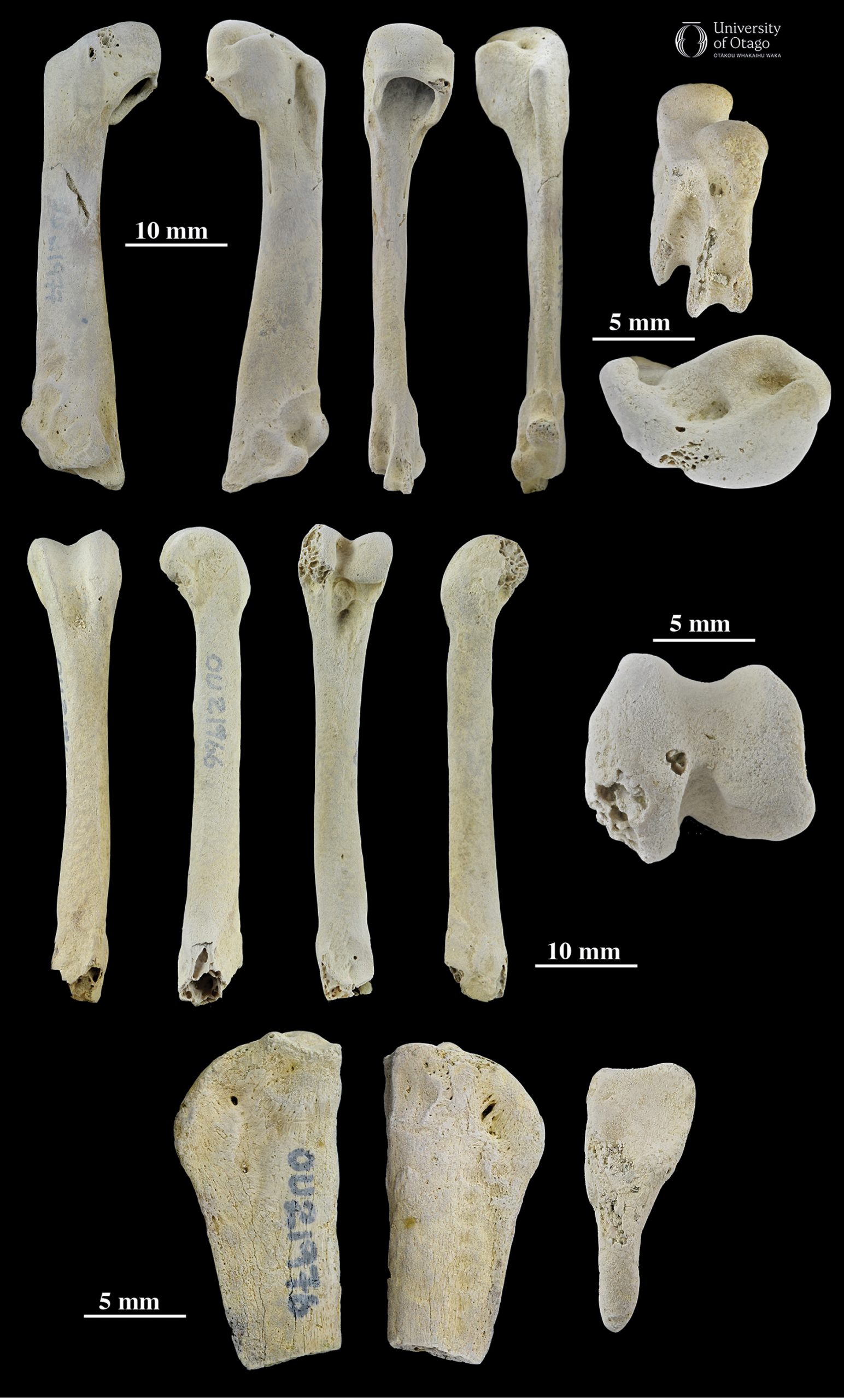19 Small penguin was forerunner of today’s tiny divers
Aves, Sphenisciformes: Pakudyptes hakataramea
Penguins today range in size from kororā little penguin Eudyptula minor, standing around 30 cm tall and weighing one kilogram, up to emperor penguin Aptenodytes forsteri, an order of magnitude larger at one metre tall and weighing around 35 kg. Ancient penguins famously reached even larger sizes with Kumimanu fordycei (named for Ewan Fordyce) standing more than 1.5 m tall and weighing much more than an emperor penguin. Penguin body size has several important biological and ecological consequences, and researchers have been studying penguin anatomy, ecology and evolution for more than a century to gain insight into how penguins have adapted to life in water.

Bones from the tiny penguin Pakudyptes hakataramea (specimen OU 21977). The top row shows different views of the uppermost bone from the wing (humerus). The middle row shows different views of the thigh bone (femur) and the bottom row shows different views of the forearm bone (ulna). Pakudyptes hakataramea was a very similar size to living kororā or little penguin (Eudyptula minor) from Aotearoa and Australia. Image source: Figure 2 in T Ando, JH Robinson, C Loch, T Nakahara, S Hayashi, M Richards and RE Fordyce (2024) A new tiny fossil penguin from the Late Oligocene of New Zealand and the morphofunctional transition of the penguin wing, which is licensed under CC BY-NC-ND 4.0. Image credit: JH Robinson. |
Researchers have discovered that body size influences how a penguin manages heat and finds food. Larger penguins cool down more slowly which means they can endure being in colder water for longer. In contrast, smaller penguins have a reduced risk of overheating in warmer climates. Larger penguins can dive deeper and swim greater distances from shore, whereas smaller penguins can typically meet their energy demands from local food sources closer to shore.
 |
Did you know there is a 3D printable model of this fossil for you to view online and download? Follow this link to learn more: 3D model—Small penguin was forerunner of today’s tiny divers. |
The correlation between penguin body size and environment gains a new dynamic when we realise that marine environments have experienced radical change over time. The capacity to tolerate environmental change can vary with body size, and so there are many questions about adapting to changing marine environments that are best answered by studying the smallest fossil penguins. While bones from small ancient penguins are generally rare, the University of Otago Geology Museum is fortunate to house fossils from one of the tiniest fossil penguins ever discovered.
In 1987 Craig Jones and Ewan Fordyce collected three small penguin bones (humerus, ulna and femur) from a limestone quarry in South Canterbury, New Zealand. These bones are from a penguin that was approximately the same size as living kororā. The Otekaike Limestone from which these the bones were collected represents an inner- to mid-shelf marine environment, like the type of environment that kororā forages in today. Otekaike Limestone was deposited towards the end of the Oligocene about 24 million years ago. The bones from this tiny fossil penguin were later studied by Tatsuro Ando as part of his doctoral research.
The bones were from Pakudyptes hakataramea, a species that was new to science and therefore distinct from the tiny fossil penguin Eretiscus tonnii previously identified in South America. Tatsuro Ando observed that the wing bones of Pakudyptes hakataramea featured characteristics found only in ancient penguins, alongside traits that we find today in modern penguins. This means that Pakudyptes hakataramea was a capable swimmer but possibly not as effective at generating lift in water as modern penguins. From this we can better understand that the swimming efficiency of penguins has been gradually improving through time.
Pakudyptes hakataramea is the oldest ‘tiny’ penguin now known, helping to show that the penguins have had a broad range in body sizes for many millions of years.
—Written by Daniel B Thomas
| Specimen number: OU 21977 | Age: Approximately 26 million years old (late Oligocene, Duntroonian stage) |
| Locality: Hakataramea Valley, South Canterbury | Rock Formation: Otekaike Limestone |
| Collected by: CM Jones, RE Fordyce | |
| Citation: Ando T, Robinson JH, Loch C, Nakahara T, Hayashi S, Richards M, Fordyce RE. 2024. A new tiny fossil penguin from the Late Oligocene of New Zealand and the morphofunctional transition of the penguin wing. Journal of the Royal Society of New Zealand 54:660–681. doi:10.1080/03036758.2024.2362283 | |
Evidence of life from a past geological age. Remains like bones, shells or wood, or an impression like a footprint, or some other evidence of life, from something that was alive more than 11,700 years ago.
Penguins. An order of seabirds with around 20 living species in a single family (Spheniscidae). Many more extinct species of penguin are known compared with the number of living species.
The bone in the forelimb of a vertebrate (i.e. wing, arm, flipper) that connects with the shoulder.
A bone in the forelimb of a vertebrate (i.e. wing, arm, flipper) that connects with the humerus to form the 'forearm'.
A bone in the hindlimb of a vertebrate (i.e. back leg) that connects with the pelvis. Commonly known as the thigh bone.
Coarse-grained, sandy limestone.
The extended margin of a continent which is submerged under relatively shallow seas. While the width of the shelf varies between continents, most shelf seas are generally less than 100 metres deep.
Approximately 27 to 23.03 million years ago. The late Oligocene is not a formally defined segment of geological time, but instead refers to the final three or four million years of the Oligocene Epoch.

